Mtdna - Samenvattingen, Aantekeningen en Examens
Op zoek naar een samenvatting over Mtdna? Op deze pagina vind je 121 samenvattingen over Mtdna.
Pagina 2 van de 121 resultaten
Sorteer op
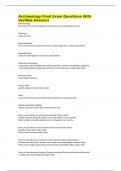
-
Archaeology Final Exam Questions With Verified Answers
- Tentamen (uitwerkingen) • 9 pagina's • 2024
-
- €11,06
- + meer info
Archaeology Final Exam Questions With Verified Answers Bioarcheology the study of the human biological component of the archaeological record Osteology Study of bones Burial Population A set of human burials that come from a certain region and a certain time period Paleopathology study of ancient patterns of diseases and disorders Molecular Archaeology uses genetic material (DNA) from ancient people to reconstruct population migrations - mitochondrial DNA and genetic m...
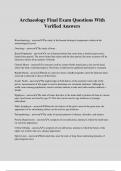
-
Archaeology Final Exam Questions With Verified Answers
- Tentamen (uitwerkingen) • 18 pagina's • 2024
-
Ook in voordeelbundel
-
- €12,35
- + meer info
Archaeology Final Exam Questions With Verified Answers Bioarchaeology - answerThe study of the human biological component evident in the archaeological record Osteology - answerThe study of bone Burial Population - answerA set of human burials that come from a limited region and a limited time period. The more limited the region and the time period, the more accurate will be inferences drawn from analysis of burials Charnel House - answerA structure used by eastern North Americans to lay...
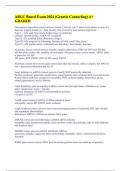
-
ABGC Board Exam 2024 (Genetic Counseling) A+ GRADED
- Tentamen (uitwerkingen) • 4 pagina's • 2024
-
Ook in voordeelbundel
-
- €8,39
- + meer info
Osteogenesis imperfecta correct answers Genes: COL1A1 (ch17; more severe pheno w/mutn b/c there are 2 alpha strands vs. 1 beta strand), COL1A2 (ch7), form protein triple helix Type I -- AD, mild, blue sclera, brittle bones, no deformity collagen: normal quality, AMOUNT is reduced Type II: AD, neonatal lethal, abnormal collagen Type III: AD, progressive deforming, fractures at birth, small, blue sclera Type IV: AD, normal sclera, mild/mod bone deformity, short stature, fractures Alzheimer...
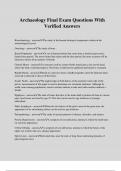
-
Archaeology Final Exam Questions With Verified Answers
- Tentamen (uitwerkingen) • 18 pagina's • 2024
-
- €12,35
- + meer info
Archaeology Final Exam Questions With Verified Answers Bioarchaeology - answerThe study of the human biological component evident in the archaeological record Osteology - answerThe study of bone Burial Population - answerA set of human burials that come from a limited region and a limited time period. The more limited the region and the time period, the more accurate will be inferences drawn from analysis of burials Charnel House - answerA structure used by eastern North Americans to lay...
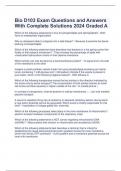
-
Bio D103 Exam Questions and Answers With Complete Solutions 2024 Graded A
- Tentamen (uitwerkingen) • 12 pagina's • 2024
-
Ook in voordeelbundel
-
- €10,37
- + meer info
Which of the following statements is true for phospholipids and sphingolipids? - Both have an amphiphatic organization Why is cholesterol able to integrate into a lipid bilayer? - Because it prevents the dense packing of phospholipids Which of the following statement best describes how bacteria in a hot spring control the fluidity of their plasma membrane? - They increase the percentage of lipids with unsaturated hydrocarbon chains in their plasma membrane. Which activity can only be do...
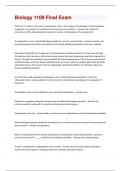
-
Biology 1108 Final Exam Questions With Correct Answers!!
- Tentamen (uitwerkingen) • 11 pagina's • 2024
-
Ook in voordeelbundel
-
- €7,90
- + meer info
The term "n" refers to the size of a population, that is, the number of individuals in that population. In general, in a sample of n individuals, the frequency of an allele is: - Answer-the number of occurrences of the allele divided by twice the number of individuals in the sample (2n) If a population is not in Hardy-Weinberg equilibrium, we can conclude that: - Answer-evolution has occurred because one of the assumptions of the Hardy-Weinberg equilibrium has been violated The goldenrod ...

-
DNA Profiling UPDATED Exam Questions and CORRECT Answers
- Tentamen (uitwerkingen) • 5 pagina's • 2024
-
- €7,90
- + meer info
DNA" stands for what?deoxyribonucleic acid Do all human cells contain DNA?No, red blood cells do not contain DNA. (Why not? Because there is no nucleus or mitochondria in these cells.) DNA is found in 2 places in the human body. Name them.1. in the chromosomes inside the nucleus of cells (nuclear DNA) 2. inside the mitochondria (mtDNA)
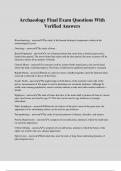
-
Archaeology Final Exam Questions With Verified Answers
- Tentamen (uitwerkingen) • 18 pagina's • 2024
-
Ook in voordeelbundel
-
- €13,34
- + meer info
Archaeology Final Exam Questions With Verified Answers Bioarchaeology - answerThe study of the human biological component evident in the archaeological record Osteology - answerThe study of bone Burial Population - answerA set of human burials that come from a limited region and a limited time period. The more limited the region and the time period, the more accurate will be inferences drawn from analysis of burials Charnel House - answerA structure used by eastern North Americans to lay...
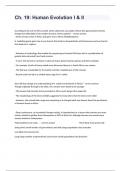
-
Ch. 19: Human Evolution I & II Questions With Explanations Of Answers.
- Tentamen (uitwerkingen) • 8 pagina's • 2024
-
Ook in voordeelbundel
-
- €12,84
- + meer info
According to the out-of-Africa model, which statement accurately reflects the approximate hominin lineage that ultimately led to modern humans, Homo sapiens? - correct answer - Homo erectus arises in Africa and gives rise to Homo heidelbergensis H. heidelbergensis gives rise to one branch that leads to Neanderthals and Denisovans and one branch that leads to H. sapiens - Advances in technology that enable the sequencing of ancient DNA have led t...

-
PMB 3212 Exam 1 Questions and Answers | Already passed | Latest Update
- Tentamen (uitwerkingen) • 27 pagina's • 2024
-
- €12,05
- + meer info
oldest fungal fossils : Rhynie Chert (Scotland): 400 myo African fossil: 800 myo phylogenetic tree of life : shows when lineages are thought to have emerged divergence times based on fossil and molecular data foray table : used to preliminarily organize finds from a foray into phyla and subphyla fungi as plants : considered plants until recently now considered a separate kingdom taxonomy 2 : nomenclature of organisms classification : orders names of organisms (part of taxonomy) s...

Vraag jij je af waarom zoveel studenten in mooie kleren lopen, geld genoeg hebben en genieten van tonnen aan vrije tijd? Nou, ze verkopen hun samenvattingen op Stuvia! Stel je eens voor dat jouw samenvatting iedere dag weer wordt verkocht. Ontdek alles over verdienen op Stuvia


